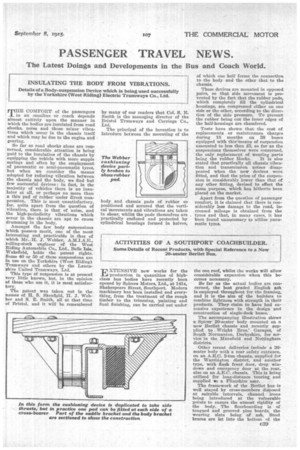INSULATING THE BODY FROM VIBRATIONS.
Page 23

If you've noticed an error in this article please click here to report it so we can fix it.
Details of a Body-suspension Device which is being used successfully by the Yorkshire (West Riding) Electric Tramways Co., Ltd.
T"COMFORT of the passengers in an omnibus or coach depends almost entirely upon the manner in
which the bodies are insulated from road shocks, noise and those minor vibra tions which occur in the chassis itself and which may be due to the engine and gearing.
So far as road shocks alone are conCerned, considerable attention is being
paid to the insulation of the chassis by equipping the vehicle with more supple springs and often by the employment of pneumatic or semi-pneumatic tyres, but when we consider the means adopted for reducing vibration between the chassis and the body, we find but few successful devices ; in fact, in the majority of vehicles there is no insu lator at all, or perhaps no more than a thin pad of rubber under direct compression. This is most unsatisfactory, for, quite apart from the question of vibration, there is that of noise, and the high-periodicity vibrations which occur in the chassis are apt to cause drumming in the body.
Amongst the few body suspensions Which possess merit, one of the most interesting and practicable is that of which Mr.. H. J. Webber, A.M.I.A.E., rolling-stock engineer of the West Riding Automobile Co., Ltd., Belle Isle, Wakefield, holds the patent rights. Some 40 or 50 of these suspensions are in use on the Yorkshire (West Riding) Tramways and others by the Lancashire United Tramways, Ltd.
This type of suspension is at present very little known, but, in the opinion of those who use it, it is most satisfactory,
The patent was taken out in the names of H. S. Skenfield, H. J. Web ber and S. E. Smith, all at that time of Bristol, and it will be remembered by many of our readers that Col. S. E. Smith is the managing director of the Bristol Tramways and Carriage Co., Ltd.
The principal of the invention is to introduce between the mounting of the body and chassis pads of rubber so positioned and secured that the vertical movements and vibrations are taken in shear, whilst the pads themselves are practically enclosed and protected by cylindrical housings formed in halves, of which one half forms the connection to the body and the other that to the chassis.
These devices are mounted in opposed pairs, so that side movement is prevented by the fact that the rubber pads which completely fill the cylindrical. housings, are compressed either on one side or the other, according to the direction of the side pressure. To prevent the rubber being cut the inner edges of the half-housings are chamfered.
Tests have shown that the cost of replacements or maintenance charges during 18 months on 38 buses equipped with this means of suspension amounted to less than £5, so far as the suspensions themselves were concerned, the only replacement of wearing parts being the rubber blocks. It is also stated that practically all chassis vibration and transmission noises disappeared when the new devices were fitted, and that the price of the suspension is considerably lower than that of any other fitting, devised to effect the same purpose, which has hitherto been placed on the market.
Apart from the question of passenger comfort, it is claimed that there is considerably less damage to the road, increased mileage is obtained from the tyres and that, in many cases, it has been found unnecessary to utilize pneumatic tyres.






























